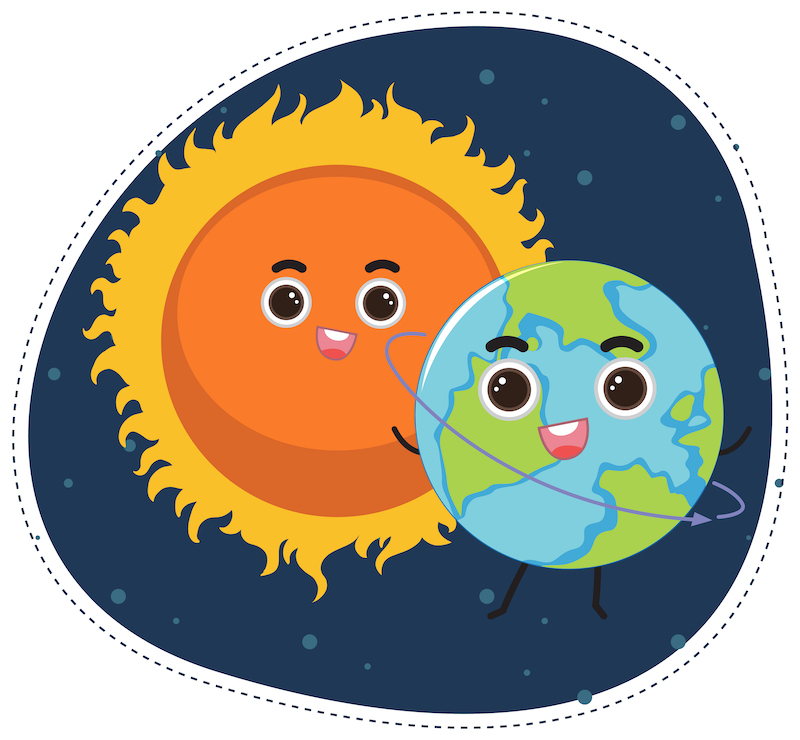Understanding the Distance from the Earth to the Sun

Hey there, young scientists! 🌞
Have you ever gazed up at the sky and wondered just how far away the Sun really is? 🌅🔆Understanding the distance from the Earth to the Sun is not only fascinating but also fundamental to comprehending the dynamics of our solar system. Today, we’re going to explore a fascinating topic: the distance between our planet Earth and the Sun☀️. As we learn more about this incredible distance, we’ll discover how it affects our world and what factors influence it. So, let’s dive in! 🌍🚀

What is the Average Distance from the Earth to the Sun, and how is this Distance Measured?
Did you know that the average distance from the Earth to the Sun is about 93 million miles (149.6 million kilometers)? That’s a huge number! Scientists use a special unit called an astronomical unit (AU) to measure this distance. One AU is equal to the average distance between the Earth and the Sun. To measure this distance, scientists use a method called “parallax.” They look at the Sun from different points on Earth’s orbit and measure how much its position appears to change. By doing some math, they can calculate the distance between the Earth and the Sun.
Measuring the Distance: The concept of an astronomical unit serves as a standard unit of measurement for distances within our solar system. Astronomers use various methods to determine the Earth-Sun distance, including geometric calculations based on the Earth’s orbit and observations of planetary motions.
How does the Earth’s distance from the Sun affect its Temperature and Climate?
The Earth’s distance from the Sun plays a big role in our planet’s temperature and climate. Just like how you feel warmer when you stand closer to a fire, the Earth’s temperature is affected by its distance from the Sun. If the Earth were closer to the Sun, it would be much hotter, and if it were farther away, it would be much colder. Despite the variation in distance, the tilt of the Earth’s axis is the primary driver of seasonal changes.The perfect distance allows Earth to have the right conditions for life to thrive, with a variety of climates and seasons.

Does the Distance Between the Earth and the Sun remain Constant throughout the year, or does it vary?
Did you know that the distance between the Earth and the Sun doesn’t always stay the same? It actually varies throughout the year! The Earth’s orbit around the Sun is not a perfect circle; it’s slightly oval-shaped. This means that sometimes the Earth is a little closer to the Sun, and at other times, it’s a little farther away. When the Earth is closest to the Sun, it’s called “perihelion,” and when it’s farthest away, it’s called “aphelion.” However, these changes in distance are relatively small compared to the total distance.
During the Earth’s closest approach to the Sun (perihelion) in early January, the distance is approximately 91.4 million miles (147.1 million kilometers). Conversely, during its farthest point (aphelion) in early July, the distance increases to about 94.5 million miles (152.1 million kilometers).
What factors influence the variation in distance between the Earth and the Sun over time?
Several factors can influence the Earth’s distance from the Sun over long periods of time. One of these factors is the gravitational pull of other planets in our solar system. As the planets orbit the Sun, their gravity can slightly tug on the Earth, causing its orbit to change shape very slowly over thousands or even millions of years. Another factor is the Sun’s mass. As the Sun loses mass through nuclear fusion, its gravitational pull on the Earth weakens slightly, causing the Earth to drift away very gradually.
How does the Distance from the Earth to the Sun affect the Length of the Earth’s Orbit and the Duration of a Year?
The Earth’s distance from the Sun also determines the length of its orbit and the duration of a year. It takes the Earth about 365.25 days to complete one full orbit around the Sun. This is why we have leap years every four years to keep our calendars in sync with the Earth’s orbit. If the Earth were closer to the Sun, its orbit would be shorter, and a year would be shorter too. If the Earth were farther from the Sun, its orbit and a year would be longer.
Implications for Space Exploration: Understanding the Earth-Sun distance is not only essential for studying our planet’s climate but also for planning space missions. Spacecraft navigating through our solar system must account for the varying distances to optimize trajectories and fuel efficiency.
The distance from the Earth to the Sun may seem vast and incomprehensible, yet it is a fundamental aspect of our existence within the cosmos. By delving into the intricacies of this celestial journey, we gain a deeper appreciation for the interconnectedness of our planet and the greater universe. So, the next time you bask in the warmth of the sunlight or gaze up at the starry night sky, take a moment to marvel at the incredible journey spanning 93 million miles that connects us to the heart of our solar system.🌅🔆🌻
Quiz and Questions on the Above Passages
Q1.What is the average distance from the Earth to the Sun?
a) 93 thousand miles
b) 93 million miles
c) 160 thousand kilometers
d) 120 million kilometers
Q2.What unit do scientists use to measure the distance between the Earth and the Sun?
a) Miles
b) Kilometers
c) Astronomical unit (AU)
d) Light-years
Q3.How do scientists measure the distance between the Earth and the Sun?
a) By using a giant ruler
b) By using a method called “parallax”
c) By sending a spacecraft to measure the distance directly
d) By guessing based on the size of the Sun
Q4.If the Earth were closer to the Sun, what would happen to its temperature?
a) It would become much colder
b) The temperature would not change
c) It would become much hotter
d) It would have more extreme seasons
Q5. The Earth’s orbit around the Sun is:
a) A perfect circle
b) Constantly changing shape
c) A straight line
d) Slightly oval-shaped
Q6.When the Earth is closest to the Sun, it is called:
a) Aphelion
b) Perihelion
c) Solstice
d) Equinox
Q7. Which factor primarily drives seasonal changes on Earth?
a) Tilt of Earth’s axis
b) Variation in Earth’s distance from the Sun
c) Changes in Earth’s orbit
d) Solar flares from the Sun
Q8.Describe how the Sun’s mass loss through nuclear fusion can influence the Earth’s distance from the Sun over time.
Q9.Discuss why leap years are necessary to keep our calendars in sync with the Earth’s orbit around the Sun.
A1. b)
A2. c)
A3. b)
A4. c)
A5. d)
A6. b)
A7. a)
Glossary:
- Astronomical unit (AU): A unit of measurement equal to the average distance between the Earth and the Sun, approximately 93 million miles (149.6 million kilometers).
- Parallax: A method used by scientists to measure the distance between the Earth and the Sun by observing the Sun’s apparent position change from different points on Earth’s orbit.
- Perihelion: The point in the Earth’s orbit where it is closest to the Sun.
- Aphelion: The point in the Earth’s orbit where it is farthest from the Sun.
- Gravitational pull: The force of attraction between objects with mass, such as planets and the Sun.
- Nuclear fusion: The process by which the Sun generates energy by combining lighter atomic nuclei to form heavier nuclei, resulting in a loss of mass.
- Orbit: The path followed by an object, such as a planet, as it revolves around another object, like the Sun.
- Leap year: A year with an extra day (February 29th) added every four years to keep the calendar in sync with the Earth’s orbit around the Sun, as the Earth takes approximately 365.25 days to complete one orbit.
Click Now to Discover How Planets Really Move Around the Sun!🌟
And remember, even on a bad day, at least you’re still not as far from the Sun as Pluto! 🌞😄
N.G.T



